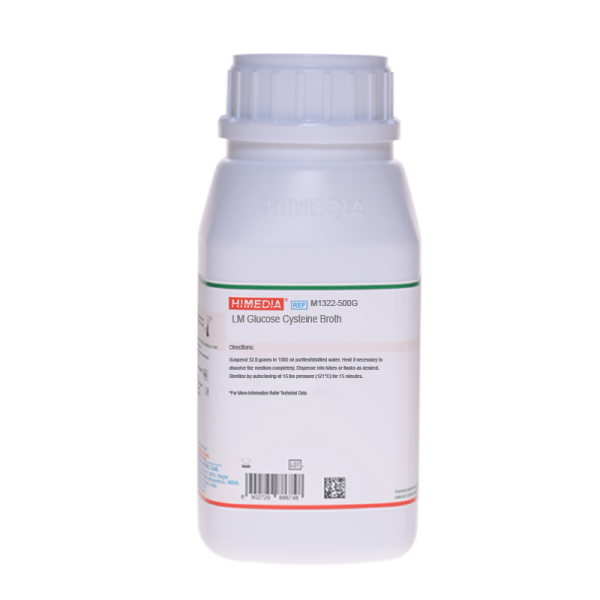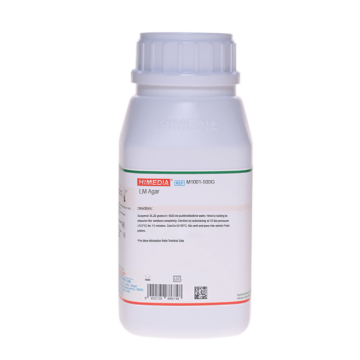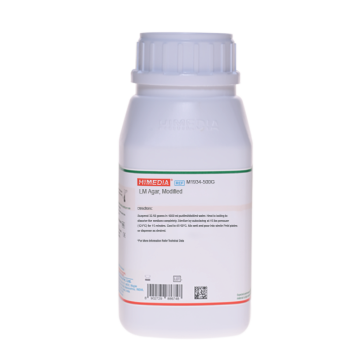 Your enquiry has been submitted
Your enquiry has been submitted
LM Glucose Cysteine Broth (Liver Meat Glucose Cysteine Broth)
Intended Use
Recommended for cultivation of fastidious anaerobes.
Composition
| Ingredients | Gms / Litre |
|---|---|
| HML Base # | 29.500 |
| Glucose | 2.000 |
| L-Cysteine hydrochloride | 0.500 |
| Final pH (at 25°C) | 7.4±0.2 |
**Formula adjusted, standardized to suit performance parameters
# Equivalent to Liver meat base
Directions
Suspend 32.0 grams in 1000 ml purified / distilled water. Heat if necessary to dissolve the medium completely. Dispense into tubes or flasks as desired. Sterilize by autoclaving at 15 lbs pressure (121°C) for 15 minutes.
Principle And Interpretation
Anaerobic bacteria live in an oxygen-free environment. Some anaerobic bacteria actually die if oxygen is present, while others fail to grow and multiply (1).
LM Glucose Cysteine Broth is recommended for the cultivation of fastidious anaerobic organisms. The medium contains HML Base which is a rich source of vitamins, the haem group and other nutrients that support the growth of strict and nutritionally fastidious anaerobes. Besides, it also provides sufficient degree of anaerobiosis in the medium. L-Cysteine hydrochloride has a dual function in that it acts as a nutrient and the sulphydral group present in it helps to create anaerobic conditions. Glucose provides source of energy.
Type of specimen
Clinical samples; Food samples
Specimen Collection and Handling
For clinical samples follow appropriate techniques for handling specimens as per established guidelines (2,3).
For food samples, follow appropriate techniques for sample collection and processing as per guidelines (4).
After use, contaminated materials must be sterilized by autoclaving before discarding.
Warning and Precautions
Read the label before opening the container. Wear protective gloves/protective clothing/eye protection/face protection. Follow good microbiological lab practices while handling specimens and culture. Standard precautions as per established guidelines should be followed while handling specimens. Safety guidelines may be referred in individual safety data sheets.
Limitations
- Further biochemical and serological test must be carried out for complete identification.
Performance and Evaluation
Performance of the medium is expected when used as per the direction on the label within the expiry period when stored at recommended temperature.
Quality Control
Appearance: Yellow to brownish yellow homogeneous free flowing powder
Colour and Clarity of prepared medium: Amber coloured clear to slightly opalescent solution
Reaction: Reaction of 3.2% w/v aqueous solution at 25°C. pH: 7.4±0.2
pH: 7.20-7.60
Cultural Response
Cultural characteristics observed after in an anaerobic environment after an incubation at 35-37°C for 24-48 hours.
| Organism | Growth |
|---|---|
| Bacteroides vulgatus ATCC 8482 | good-luxuriant |
| Clostridium botulinum ATCC 25763 | luxuriant |
| Clostridium perfringens ATCC 12924 | luxuriant |
Storage and Shelf Life
Store between 10-30°C in a tightly closed container and the prepared medium at 15-25°C. Use before expiry date on the label. On opening, product should be properly stored dry, after tightly capping the bottle in order to prevent lump formation due to the hygroscopic nature of the product. Improper storage of the product may lead to lump formation. Store in dry ventilated area protected from extremes of temperature and sources of ignition. Seal the container tightly after use. Product performance is best if used within stated expiry period.
Disposal
User must ensure safe disposal by autoclaving and/or incineration of used or unusable preparations of this product. Follow established laboratory procedures in disposing of infectious materials and material that comes into contact with sample must be decontaminated and disposed of in accordance with current laboratory techniques (2,3).
Reference
- Alcamo E. I., 2001, Fundamentals of Microbiology, 6th Ed., Jones and Bartlett Publishers.
- Isenberg, H.D. Clinical Microbiology Procedures Handbook 2nd Edition.
- Jorgensen, J.H., Pfaller, M.A., Carroll, K.C., Funke, G., Landry, M.L., Richter, S.S and Warnock., D.W. (2015) Manual of Clinical Microbiology, 11th Edition. Vol. 1.
- Salfinger Y., and Tortorello M.L. Fifth (Ed.), 2015, Compendium of Methods for the Microbiological Examination of Foods, 5th Ed., American Public Health Association, Washington, D.C.
| Product Name | LM Glucose Cysteine Broth (Liver Meat Glucose Cysteine Broth) |
|---|---|
| SKU | M1322 |
| Product Type | Regular |
| Physical Form | Powder |
| Origin | Animal |
| Packaging type | HDPE |
| References | 1.Alcamo E. I., 2001, Fundamentals of Microbiology, 6th Ed., Jones and Bartlett Publishers |
| Customized Product Available | No |








